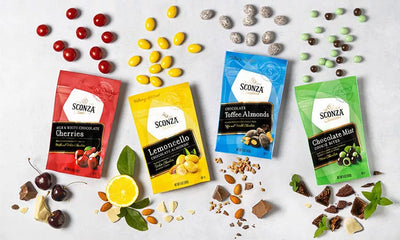
You’ve probably found a tiny organza bag of these in your purse after a wedding, or maybe wrapped them up with a bow for a baby shower. Jordan almonds are almonds coated with a hard sugar shell. Today, Jordan almonds are often used as wedding favors or for other special occasions. They are typically sold in a mix created with an array of shiny, gorgeous pastel colors, but traditional brides also love the simplicity of white. The history of Jordan almonds holds a special place in the hearts of the Sconza family with strong ties to Italian traditions.
The History
While the name might suggest that Jordan almonds come from the Jordan Valley, most modern scholars believe the sweet actually originated in Rome. In 177 BC, confectioner Julius Dragatus first invented honey-coated almonds and seeds. He named the new treat “dragati” for his namesake. They were typically served as party favors at weddings and births, much like their purpose today.
Since sugar wasn’t widespread in the area at the time, it would be many centuries before Jordan almonds gained the sugar coating we know today. During the Crusades, Europeans brought sugar back to their homeland. In the 13th century, an apothecary in Verdun, France, began to coat medicines in sugar. He called the new concoctions dragées. They believed sugar had medicinal properties, and it made medicines have a better taste. Sometimes almonds were sugar coated and highly prized for their medicinal value.
In the 15th century, Jordan almonds were eventually popularized in Sulmona, Italy. They were still referred to as dragées, but rather than for medicinal purposes, they existed only as a sweet treat. The Pelino family perfected this concoction, and their legacy still lives on through the Pelino Museum in Italy.
Fast forward a few centuries to the 1940s when Vincenzo Sconza and his family begin to share the tradition of Jordan almonds here in the United States.


How they got the name
The origins of the name “Jordan almond” are slightly unclear and are widely debated. Many believe it to be a corruption of the French word for garden, “jardin.” This was used to differentiate garden almonds from the typical wild variety. Wild almonds are poisonous due to a compound known as amygdalin, which breaks down into cyanide and a few other chemicals. Through years of cultivation, garden almonds were developed as a nontoxic and edible variant. However, some have argued that the Jordan in Jordan almonds refers to the region, where garden almonds were commonly grown. Some also believe that the name is a corruption of Verdun, which is where the dragées originated. While there is no official consensus, all of these different names refer in some way to the origins of either the almond variant or the treat itself.
Names Around the World
Jordan almonds actually go by many names, which are different depending on the region you’re in. In Italy, they’re commonly referred to as “confetti.” While this may sound like the name comes from the Jordan almond’s variety of colors, it’s actually believed to originate from the Latin word “confectum,” meaning “wrapped.” This refers to how the candies are traditionally wrapped in small bags. Some Italians also refer to them as “confetto,” meaning “confectionery.”
In Arabic, Jordan almonds are referred to as “mlabas.” This means “coated” or “covered,” and refers to the sugar coating on the almonds. Other names for Jordan almonds are less region-specific. Some other names for Jordan almonds include “koufeta,” or simply “sugared almonds.” Many still refer to Jordan almonds as “dragées,” a callback to their historical origins.


Purpose of Jordan Almonds
Since their origins in Rome, Jordan almonds have traditionally been used as a wedding favor and are still used for that purpose today. The traditional bomboniere includes five Jordan almonds, which symbolize health, wealth, happiness, fertility, and a long life.
Jordan almonds are thought to be a fertility symbol due to their egg shape. They are also thought to represent the bittersweet nature of life considering the almond’s bittersweet flavor.
The five almonds are wrapped in tulle, which is tied at the top with a ribbon and given to wedding guests.
Throughout history, different colors of Jordan almonds were usually used for different occasions. White Jordan almonds were usually used for weddings, and pink and blue Jordan almonds were usually used for baby showers. Some still use the color symbolism to this day. Others in modern times purchase Jordan almonds in a pastel mix bag and simply enjoy them for their delicious and colorful nature.
If you’d like to try Jordan almonds or any of our other sweet confections at Sconza Chocolates, be sure to check out our shop page today.

